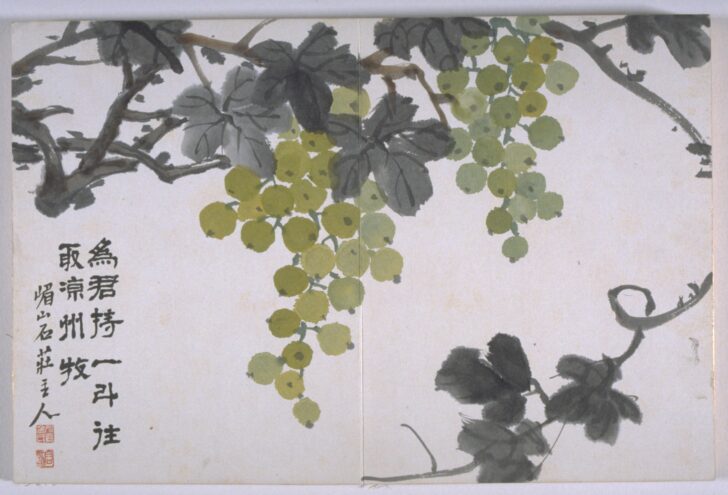Fourteen Fruit and Flower Sketches
Yong-chin Kim

Description
Kim Yongjin
Korea, 1878–1968
Flowers
1946
Album, ink and color on paper
Museum Purchase, 1952/2.5
Kim Yongjin is renowned for both his ink paintings
of flowers and his calligraphy. He often combines
painting and poetry in his work, and both are integral
to the viewer’s experience. This accordion style album
consists of fourteen paintings of fruits and flowers,
each accompanied by lines of poetry that expand on the
subject. On this page, a branch painted in a light ink
wash bears two clusters of small, ripe fruits loquats, and
the inscription says:
蘆蘆蘆蘆蘆蘆蘆
The loquats are ripening in summer
Hyangseok-ong (literary name of Kim Yongjin)
Spring/Summer 2021 Gallery Rotation
__________
This enchanting album of brightly colored fruits and flowers has a unique, double-sided format, with sheets mounted on both the front and reverse of each leaf. The paintings belong to the genre of “bird and flower painting,” which has a long tradition in East Asia, but the approach is modern, with unusual flowers and fruits depicted alongside canonical subjects such as orchids and rocks, bamboo, and grape vines.
The use of strong diagonal compositions is also fresh and lively.
The last painting in the album (not on view) bears an inscription: “[painted by] an old man of 69 years, Kim Yong-jin, in the year Byeongsul [1946].”
Spring/Summer Gallery Rotation 2015
---------------
Winter 2015 Gallery Rotation
This enchanting album of fruits and flowers in bright colors has a unique double-sided format, with sheets mounted on both the front and reverse of the page. The paintings belong to the genre of “bird and flower painting,” which has a long tradition in East Asia, but the approach is modern, with more unusual flowers and fruits depicted alongside canonical subjects such as orchids and rocks, bamboo, and grape vines. The use of strong diagonal compositions is also fresh and lively. The last painting of the album,depicting what are called “Buddha’s hand” fruits (because their shape resembles human hands) bears an inscription: “[paintedby] an old man of 69 years, Kim Yong-jin, in the year Byeongsul.”This indicates that the artist painted the album
Subject Matter:
Image 1: Peony flowers
Image 2: Kumquats
Image 3: Lotus flower
Image 4: Possibly apples
Image 5: Orchids
Image 6: Grapes
Image 7: Asiatic Lilies
Image 8: Pomegrante
Image 9: Bamboo
Image 10: Oranges
Image 11: Unknown plant
Image 12: Raspberries
Image 13: Chrysanthemums
Image 14: Unknown, possibly tropical flower
Physical Description:
Various sketches of fruits and flowers each with accompanying calligraphy.
Image 1: Large white flower in the upper left balanced by a large gray rock in the lower right. A smaller pink flower completes the visual triangle.
Image 2: A branch bearing two clusters of small orange fruits begins in the upper left and ends lower, center.
Image 3: A branch of white and pink flowers starts center right and moves off the page at upper center.
Image 4: A branch bearing three large green fruits starts and the upper left corner and ends just right of center. Two fruits centrally located and the third is in the upper left.
Image 5: Rock-mass in the upper right with green grass-like plants and light green orchids.
Image 6: Fruit-bearing vine moves across the top of the page and crosses over the lower right corner.
Image 7: Two large orange blooms are located slightly left of center and near the top. Opposite those the lower right half is dominated by a large rock formation.
Image 8: Two large orange-ish red fruits are located slightly below the center of the paper.
Image 9: Green leaves move from the upper right corner towards the lower left. In the lower left is a rock formation.
Image 10: Two large orange fruits are slighly off center and a small branch is in the upper right corner.
Image 11: A plant with red leaves moves from the upper right to the lower left. It is visually divided by a rock formation.
Image 12: One cluster of red fruits is slight below the center of the page, while another cluster is located more towards the upper right corner.
Image 13: Blooms of flowers curve up the page from the lower left to the center. There are three white blooms near the bottom left and two yellow ones near the top of the page.
Image 14: Three large blooming flowers are centrally located on the page. Two are slightly toward the left while the third is slightly toward the right.
The title section or the front cover of this folding painting album is empty. The album is mounted on brown silk with a pine cone design, and is unusual in that paintings are also featured on the reverse side of each page. The album thus consists of fourteen pages and seven paintings on every two-facing-pages. Using a diagonal composition, Kim has painted a variety of fruits and flowers in yellow, bright green and orange, thus revitalizing traditional motifs with a modern aesthetic sensibilities. Each painting is inscribed with Kim’s various pen names such as “Guryong-sanin (九龍山人),” “Hyangseok-ong (香石翁)” and “Yeongun-sanin (穎雲散人),” and stamped with seals reading “Yeongga Kim-ssi (永嘉金氏)” and “Yongin (容印).” The final painting features the inscription, “(painted by) an old man of 69 years, Kim Yongjin, in the year Byeongsul (丙戌六十九翁 金容鎭),” indicating that Kim produced the works in 1946 at the age of 69. The album was purchased by the University of Michigan Museum of Art from Kenny Kang in 1952.
[Korean Collection, University of Michigan Museum of Art (2017), 234]
Usage Rights:
If you are interested in using an image for a publication, please visit https://umma.umich.edu/request-image/ for more information and to fill out the online Image Rights and Reproductions Request Form.